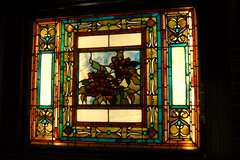
When he died in 1910 he was acclaimed as America’s only old master.
Originally uploaded by Noisypond.
The accompanying placard said:
FLORAL, c. 1890
Design and fabrication attributed to John La Farge (1835-1910). A ventilator window from an unidentified building, probably in New York.
When John La Farge, a stained-glass innovator of genius, took up the art of stained glass, there was almost nothing left of the great European tradition and practically no glass of good quality was available in the United States for making windows. He was forty years old. The year was 1875.
For his first window, made in 1878, La Farge had found a glass-maker in the United States whose richness of color was European in style. At the same time he saw everyday household items made of opalescent glass in imitation of porcelain. He visualized both glass types together as a harmonious translucent material.
The European styled glass he found in the Thill’s Flint Glass shop in Brooklyn, New York. Thill was a glassmaker from Luxembourg who made household items of opalescent glass. In Brooklyn, La Farge also met the German-trained chemist Louis Heidt. La Farge induced both men to experiment with colored opalescent glass and to make glass according to his specifications. The reason for using this glass was its unique properties. With opalescent glass the artist could obtain a three-dimensional effect without painting or shading the glass.
La Farge’s simple effort to portray flowers and objects in glass resulted in the minting of a visual language that was entirely new. The invention of the irregular line, the plastic and expressive line, in the lead-work allowed him to expand his range far wider than any artist working at that time. Yet the methods La Farge used were relatively simple and direct.
That he should have chosen glass as an appropriate medium of expression is both a mark of the times in which he lived and a revelation of his personality. In a period of great scientific discovery and development, La Farge invented a new technology for stained glass, and he sought to regenerate the craft. There are about three hundred windows securely attributed to him. Some of them have been lost. Others are being discovered.
In his lifetime, John La Farge was acclaimed an American Renaissance man: he painted exquisite still lives and landscapes in both watercolor and oil. He invested a radical new style of illustration. He created extraordinary decorative schemes for some of the nation’s most impressive churches and mansions, and he traveled throughout Japan and the South Seas. When he died in 1910 he was acclaimed as America’s only old master. And then quickly forgotten, only to be discovered again in the early 1980s.


1 comment:
Well yahoo for glass, eh?
Post a Comment